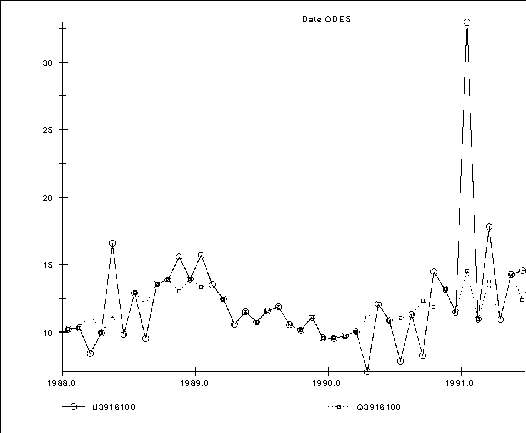MODELLING UNIT-VALUES SERIES: A TIME SERIES APPROACH TO IMPROVE PRICE INDICES IN FOREIGN TRADE
This is a report on a rather unusual application of time series modelling, a project sponsored by the FEDERAL CUSTOM AGENCY in Berne, Swit zerland. The main goal of this project is an improvement of so called unit value indices in external trade statistics. This kind of indices is no speciality of Switzerland but is also used in external trade statistics in quite a lot of countries like the USA and Canada. The main difference between genuine and unit-value indices is the fact that the former ones are based on a basket of goods considered to be respresentative for the general price development and whose composition is left unaltered as long as possible, whereas unit-value-indices are not based on a fixed basket of goods. Besides this, they are not the result of special surveys, but of custom data. Swiss custom data supply informations concerning values and quantities (usually in kilograms) for each transaction, but not on prices. The unit- value of a special tariff category, which contains more or less homogeneous goods, is simply given by a division of the total values of the im resp. exported goods in a certain month by the total quantity of these goods. In contrast to genuine price indices, unit-value indices mostly show highly volatile movements (not to say erratic ones) possibly combined with a changing variance in the course of time which can be due to a number of different causes. The most important ones are: shifts in the mix, i.e. the proportions of the various goods involved may change from from month to month, changing supplying countries or countries of destination, chan ging qualities, especially if correlated with weight reductions, recording errors ( transactions are classified into "wrong" categories). This multiplicity of possible causes make it practically impossible to identify to what a degree price changes are real ones or are due solely to non-price influences. This is especially true, if the development of thousands of prices have to be monitered every month . The graphs shown below give an impression on the fluctuating development of unit-values and unit-values indices. To dampen the high volatility of unit-values different procedures are proposed in the literature resp. used by statistical agencies. The FEDERAL CUSTOM AGENCY in Berne used a trimming procedure which is supposed to identify outliers and estimate their effects on the price development: growth rates of unit-values compared to the average value of the last year are computed, positive rates greater than 50% (resp. negative rates smaller than 30%) are limited to a change of 50% resp. 30%. Besides the fact that there is no statistical reasoning for this trimming rule, it is highly probable that the long run price development is underestimated this way. In the project mentioned above time series methods are applied in a consequent manner. The basic idea is that there are no outliers in a time se ries per se, it makes only sense to talk them if there is a frame of referen- ce. In the present context this frame is defined by time series models to be identified for series of unit-values. Taking into consideration the often erratic behaviour of unit-values it should not be surprising that for modelling them no simplistic approach, like for instance exponential smoothing, is appropriate. Rather, it proves to be necessary to use much more so phisticated approaches which allow detecting the time points at which out liers are located, estimating the size of the outlier effects and purging the unit-values from these To solve these problems, special ARIMA - transfer function models prove to be a powerful tool. The input-variables in these models have to be chosen in a way allowing modelling additive non-seasonal and seasonal out liers (pulses) and steps. After detecting outliers and estimating their im pact on unit-value series, it is possible to purge these resulting in much more damped price movements (compare the dotted lines in the plots). In the FEDERAL CUSTOM AGENCY, Berne, every month several thousands time series are purged by this methods. Of course, handling of such a huge amount of data can be done only by using an efficient software which works completely automatically. In the Berne agency a special (customized) version of AUTOBOX (engine version) is used which in addition supplies a lot of valuable statistical informations which is used for different purposes like classification, discrimination etc.


Contact person: Mr. Alois Zurwerra,
Oberzolldirektion, Monbijoustr. 40 ,
CH-3003 Berne,
phone: 0041/31/322 6575,
fax: 0041/31/322 78 72.
Click here to return to the home page
![]()
P.O. Box 563
Hatboro, PA 19040
Tel: (215) 675-0652
Fax: (215) 672-2534
![]() sales@autobox.com
sales@autobox.com
© Copyright 1997 AFS Inc.
All rights reserved.